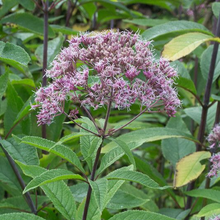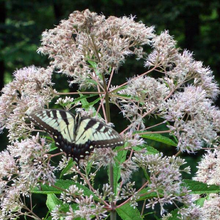Eupatorium Eutrochium fistulosum is a tall commanding native perennial that produces clouds of dusky pink to mauve flowers atop hollow purplish stems. Known for its vanilla scented blooms and robust size, it creates dramatic height in naturalized plantings and supports complex pollinator interactions through late summer and early fall. Its architectural stature also provides a seasonal backdrop in wildlife gardens.
Height & Spread: 48 - 96 in x 36 - 48 in
Bloom Time: Midsummer to early fall
Light Requirements: Full sun to part shade
Soil Preference: Moist to wet soils; tolerates clay and heavy soils
Watering Needs: Moderate to high; prefers consistent soil moisture
Deer Resistance: Moderately deer resistant due to coarse foliage
Native Status
Native to eastern and central North America, particularly along streambanks, floodplains, and moist meadows.
WILDLIFE & INSECTS
Butterflies
- Provides abundant nectar for Monarchs, Great Spangled Fritillaries, Eastern Commas, and Red Admirals during their peak migration periods.
Bees
- Supports a wide range of native bees including bumblebees, long horned bees, and miner bees as well as honeybees.
Moths
- Visited by nocturnal moths such as the Virginia Tiger Moth and day flying species like the Hummingbird Clearwing.
Birds
- Goldfinches, sparrows, and other songbirds perch on dried stalks and feed on ripening seeds into fall.
Spacing & Landscape Use
Spacing Recommendations
- Space 24 - 36 in apart to accommodate mature spread and airflow around large clumps.
Landscape Placement
- Perfect for rain gardens, wet borders, back of perennial beds, and naturalized wildflower meadows where size and pollinator value are priorities.
Companion Plants
- Symphyotrichum novae-angliae (New England Aster) - Offers deep purple fall blooms and provides nectar for migrating pollinators.
- Asclepias incarnata (Swamp Milkweed) - Shares similar soil preferences and supports Monarchs in multiple life stages.
- Rudbeckia laciniata (Cutleaf Coneflower) - Tall yellow flowers provide contrast in both form and color.
- Vernonia noveboracensis (New York Ironweed) - Offers strong verticality and rich purple blooms that peak with Eutrochium.
- Helianthus angustifolius (Swamp Sunflower) - Blooms in late summer with bright yellow daisy like flowers and thrives in similar wet habitats.



